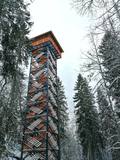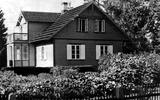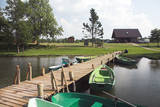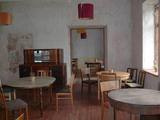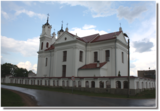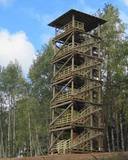| Нo | Название | Описание |
|---|---|---|
|
Dabas liegumā "Lielie Kangari" atrodas 33 metrus augsts skatu tornis, kura virsotnē atrodas platforma, no kuras paveras skats uz Kangaru ezeru un Lielkangaru purvu. Dabas liegumā izbūvēta arī nepilnu divu kilometru gara pastaigu taka ar tiltiņiem un skatu platformu pie ezera. Takas sākumā izvietotais veselības maršruts ikvienu apmeklētāju aicina kārtīgi izvingroties un izkustēties. Apmeklētāju informēšanai un izglītošanai visas takas garumā izvietoti arī informatīvie stendi ar fotogrāfijām, kas apvieno varenu stāstu un teiku kopumu par notikumiem, vietām, tēliem un parādībām dažādās apkārtnes vietās. |
||
|
Reinis Kaudzīte, co-author of the first Latvian novel “Times of the Land-Surveyors” (“Mērnieku laiki”) stayed in Pēterupe Village from 1913. |
||
|
Владельцы базы отдыха «Эзермали» предлагают прекрасную возможность для дневного отдыха на берегу живописного и прозрачного озера Звиргзду без ночлега. Сюда можно приехать на благоустроенный пляж поплавать, покататься на лодке и порыбачить. Дети смогут прокатиться на водном велосипеде. Активный отдых. Деревенская баня. В гостевом доме есть 2 комнаты на 8 человек. 6 кемпинговых домиков, 18 палаточных мест, прокат лодок. |
||
|
Этот маршрут предлагает вам отличную возможность посетить самый большой остров Эстонии – Сааремаа, который является своеобразным символом для туризма по Эстонии. На острове находятся один из наиболее впечатляющих метеоритных кратеров в Северной Европе, Епископский замок Курессааре, самая крутая отвесная скала в Эстонии и множество других интересных туристических объектов. |
||
|
This grand hiking tour is provided for experienced hikers wishing to walk along a large part of the coasts of Latvia and Estonia, gain a detailed impression about the diverse coastal landscape, nature, birds and animals of the Baltic Sea. The Baltic Coastal Hiking Route sometimes runs through sandy beaches, sometimes along sections of beach covered in stones and pebbles. Sometimes the trail goes through coastal forests or stops at a fishermen’s village. There are many floodplain meadows, lagoons and shallow bays on the Estonian side, so sometimes the path goes along coastal trails and roads. In the end section of the route you will feel Estonia’s Nordic nature more. Part of the route runs along a sparsely populated seashore where you can be alone with yourself, but you will also be able to visit the most prominent cities. You will visit both capitals: Rīga and Tallinn. Enjoy the hospitality of the resort towns of Jūrmala, Pärnu and Haapsalu. During the hike, you will also get acquainted with the regions of small ethnic cultures: the Livonians in Latvia and the inhabitants of Kihnu in Estonia. |
||
|
Meklējams pie Pāvilostas tilta pār Saku (Meža iela). Te apskatāms 2005. g. restaurētais un uz postamentiem novietotais Pāvilostas zvejnieku kuģis, ar kādu tie zvejoja pagājušā gadsimta 50. – 60. gados. Šāda tipa kuģus būvēja Vācijas Demokrātiskajā republikā. |
||
|
Мостик для велосипедистов и пешеходов через речку Киканс – границу национального природного парка Слитере. |
||
|
Братское кладбище Лачукрога –
кладбище павших во время Первой мировой
войны.
|
||
|
At the Žīguri Parish kindergarten, guests are offers a guided tour of forest life. The owner’s stories about the forest and its residents will be of interest to everyone. The Anna Āze Forestry Museum offers some of the true treasures of Latvia’s surprising forest world. It has been declared the best destination for families in Latvia.
|
||
|
История мызы началась в 19-ом веке. Сегодня мыза Пыхьяка - место питания, которое использует местные продукты и следует основам национальной кухни, здесь Вам предложат доступные простые и вкусные блюда. Меню каждого дня всегда есть на сайте. Мы рады видеть как проезжающих, так и группы. |
||
|
Для уменьшения засорения устья реки и регулирования течения в середине 19-го века был построен Восточный мол протяженностью 980 м. В основании мола находится деревянная свайная конструкция, закрытая камнями. Современный мол протяженностью 2,2 км был восстановлен в наше время и служит любимым местом для прогулок, отдыха и рыбалки во все времена года. С мола можно наблюдать за птицами, изредка может посчастливиться увидеть тюленя. В начале мола находятся два камня, выбитый на которых текст гласит, что строительство мола посетили российский император Александр II (в 1856-м году) и наследник престола Николай Александрович (в 1860-м году). Этот факт возвышает значение Рижского порта в контексте торговый путей Балтийского моря того времени. |
||
|
A comparatively large swamp to the North of the Zaļā dune, this is an important place for sulphurous waters, just as is the case with Zaļais swamp. The swamp is cut in two by the 3.5 km Ķemeri-Antiņciems road, from which interesting landscapes can be seen. The road is not appropriate for cars, however. To the East of Raganu swamp is Lake Putnezers, which is difficult to access. There is a small car park with an information stand on the shore of Lake Melnezers alongside the Ķemeri-Jaunķemeri road. The historical and overgrown Old Ķemeri road can be used to get to the seashore from this location. |
||
|
Семейное предприятие в центре Трикаты делает разнообразные шоколадные лакомства ‒ трюфели, шоколадные фигурки, а летом предлагает мороженое из молока и сливок от местных производителей. |
||
|
Находится в центре небольшого Двиете.Белый образ костела виден издалека. Первую деревянную церковь здесь построили в 1775 году под руководством владельца местной господской усадьбы графа И.К.Вишлинга. Позднее церковь снесли и перевезли на Заринкское кладбище. Строительство современного Двиетского Римско-католического костела (в стиле необарокко) с двумя башнями в 1864 году осуществлялось при помощи финансирования, предоставленного графом Казимиром Платером – Зибергом. Храм был разрушен во время Первой мировой войны, поэтому до его восстановления и освящения в 1929 г. в качестве моленной использовался магазинный амбар (двускатная гонтина) господской усадьбы «Двиете», который находится со стороны дороги Двиете – Бебрене и теперь восстановлен. В 1940 году вокруг церкви построили каменный забор, покрытый черепицей, а в 70-х годах 20 столетия построили приходской дом. В храме особенный роскошный интерьер сакрального барокко, который считается самым роскошным в бывшем Даугавпилсском районе.
|
||
|
Taka ved gar Vaidavas krastu, kur iespējams veldzēties dabas skaistumā, kāds vērojams tikai šeit. Starp Apes vidusskolu un kapsētu Vaidavas upes kreisajā krastā ir izveidojušies 8 - 10 m augsti, līdz pat 100 m gari smilšakmens atsegumi - Raganu klintis. To lejasdaļā upes straume izskalojusi nelielas nišas. Pie klintīm pāri upei izveidots gajēju tiltiņš uz otru krastu, no kura klintis paveras visā savā krāšņumā. Te ir teikām un nostāstiem apvīti avoti un alas. Avots ar skaidru ūdeni iztek no vietas, kur Vaidavas upes smilšu klints krasts ir augsts un stāvs. Senāk vietējie ticējuši, ka tas ir veselības avots, jo daudzi to lietojuši dažādām acu slimībām.Dīvainos dabas objektus – Vilkaču priedi un Dvīņu priedes, Raganu slotu, “raganu apļus”, “raganu kaulus” u.c. te var apskatīt un vides gida vadībā mēģināt izprast to veidošanos
|
||
|
Сельский гостевой дом и дендрологический сад недалеко от Кулдиги. В пруду возле дома есть форель и карп. Рядом с гостевым домом находится Саулескалнский дендрарий, основанный в 1960 году. В настоящее время здесь произрастают около 100 видов деревьев и кустарников, в т.ч. 25 - местные виды и 16 видов рододендронов. Уникальные экземпляры - самая старая магнолия в Латвии (50 лет), 45-летняя скумпия кожевенная (Cotinus coggygria), гинкго двулопастный (Ginkgo biloba), элеутерококк колючий (Acanthopanax sessiliflorum) и др. Вход за пожертвование. Имеется также помещение исторической справки о хозяевах, которые создали этот сад. Здесь можно приобрести различные саженцы. |
||
|
Это путешествие предлагает испытать одни из наиболее аутентичных впечатлений, которые вы можете получить, путешествуя по краю голубых озер в восточной чати Латвии и Литвы. В этом регионе нет туристических масс, люди здесь добры и гостеприимны, здесь находятся традиционные деревни, множество религиозных объектов и хозяйств сельского наследия. Маршрут проходит через национальный парк Разнаc, который расположен на живописном озере Разнас, вблизи традиционных сельских хозяйств и древних замков. Здесь вы можете увидеть Аглонскую базилику – святое место для паломников, а также посетить Музей хлеба в Аглоне. Далее маршрут проходит через Даугавпилс, где находится впечатляющая крепость 19-го века, в которой расположен Арт-центр Им.Марка Ротко. По дороге встречаются гончарные мастерские, где изготавливают традиционную керамику. Вы сможете узнать больше о разведении лошадей и коров, а также о том, как приготовить традиционный сыр и чай из трав. Далее маршрут пролегает через Аукштайтский национальный парк вдоль самой границы Литвы через этнографические деревни, деревянные церкви, вдоль множества озер. Стоит посетить Музей пчеловодства в Стрипейкиай, Музей искусства под открытым небом, а также Европейский центр. И, конечно же, вы сможете попробовать местное латгальское пиво и традиционное литовское блюдо - цепелины. |
||
|
Skuķu un netāli esošais Dvietes ezeri ir vieni no teritorijas grūti pieejamajiem palieņu ezeriem – lielākie šāda tipa
ezeri Latvijā. Palu laikā pārplūst, savienojoties vienā lielā ūdenskrātuvē.
|
||
|
Из Риги маршрут ведет в Сигулду, где вы сможете увидеть Олимипийскую бобслейную трассу, посетить средневековый замок Сигулду и проехать в вагончике по канатной дороге до средневекового замка Турайда, наслаждаясь видом на долину реки Гауя. Детям понравятся развлечения, предлагаемые приключенческим центром Тарзан. В парке Лигатне пройдитесь по природным тропам, для того, чтобы понаблюдать за местными дикими животными на их огороженных территориях, а также погуляйте по исторической деревне, изначально возникшей вокруг бумажной фабрики. А далее направляйтесь в Цесис, чтобы посмотреть на впечатляющие руины средневекового замка, а также на живописное обнажение девонских песчаных пород – утес Зварте в Карли. Затем маршрут идет вдоль морского побережья с его песчаными пляжами, идеальными для прогулок, игр и купания. Здесь посетите музей величайшего в мире лгуна – Мюнгхаузена и послушайте истории его необычайных приключений. Затем маршрут ведет в западную часть Латвии и фокусируется на морской и прибрежной жизни. На выезде из Риги посетите морской курорт Юрмалу, остановитесь в Музее Шоколада в Пуре, а затем направляйтесь на мыс Колка, где Рижский залив встречается с открытым морем. Затем пройдитесь по тропам Национального парка Слитере, посетите деревни ливов – одной из самых малочисленных этнических групп в мире , отведайте свежекопченой рыбы. В Вентспилсе найдете множество развлечений для детей – детский городок, узкоколейную железную дорогу, аквапарки, хорошо оборудованный пляж и парк приключений. На обратном пути в Ригу посетите очаровательную Кулдигу с ее хорошо сохранившимся деревянным зодчеством и остановитесь на ферме, где дети смогут пообщаться с сельскими животными. |
||
|
Atrodas Numerenes dabas parka teritorijā. 20 m augstais tornis uzbūvēts uz t.s. Numerenes vaļņa, no kura paveras plaša ainava un aizaugošām lauksaimniecības zemēm un nelielu mitrāju ar Kugreņa ezeru austrumu virzienā. Torņa apkaimē izveidota izziņas taka. |
||
